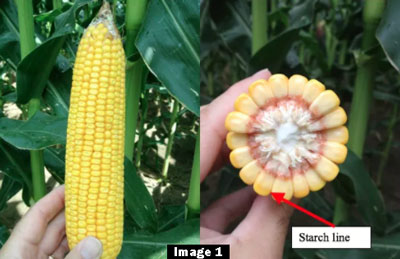
- The R5 growth stage in corn is called 'dent', which precedes the development of the 'milk line'.
- Corn reaches physiological maturity at growth stage R6, which is called 'black layer'.
- 'Black layer' marks the end of dry matter accumulation and start of dry down.
- Dry down is mostly evaporative and is highly dependent on weather conditions.
For those individuals who closely monitor the progress of the developing corn crop, below are some notes that may be helpful as the crop approaches harvest maturity.
The dent stage of corn development (R5) is when the rounded top of the corn kernel develops a depression, or dent (see Image 1). This normally occurs about 800-1000 growing degree days (GDDs), or 35-42 days after silking/pollination but is highly variable and subject to genetics and environment. Once the corn kernel dents, a "milk line" develops that can be noted on the flat face of the kernel, opposite the embryo side. The milk line is the boundary between the darker, hard starch (hard endosperm) accumulation at the top of the kernel, and the lighter colored "dough" or "soft dough" (liquid endosperm) material at the base of the kernel.
Milk line progression is often used to gauge time to physiological maturity, and is useful for scheduling final irrigation or silage harvest. A milk line halfway down the corn kernel should indicate that the crop is about 10 days from physiological maturity. Once the milk line reaches the base of the corn kernel, black layer formation should be imminent.
Physiological maturity of the corn ear (R6) normally occurs about 1200-1300 GDDs (50-60 days) after silking or roughly 20 days after kernels begin to "dent." At this stage, the kernel still needs to dry to harvest moisture, but kernel dry matter accumulation is complete. Physiological maturity is marked when a "black layer," or abscission layer, develops at the base of the corn kernel (see Image 2). This black layer is composed of compressed cells. Using a sharp knife, scalpel, or razor blade, the developing corn kernel can be split cleanly. As the black layer forms, it first appears as simply a darkened layer that then becomes brown and, finally, black.
When the black layer forms, no additional water or dry matter movement into the kernel occurs. Black layer formation generally occurs progressively in kernels from the tip of the ear toward the base of the ear. At black layer formation, the moisture content of the corn kernel should be between 25 and 40 percent (averaging about 30 percent).
Once physiological maturity has occurred, additional moisture loss from the corn kernel is primarily through evaporation. This is highly weather dependent, but is also related to tightness of husk cover, thickness of the kernel cover (pericarp), and other physical factors. Upright ears may collect water in the husk, slowing the drying process.
Late-maturing corn is expected to dry more slowly than early maturing corn because heat unit accumulation is slower as we get past mid-September. By mid-November, evaporative moisture loss is at a crawl. As a general rule of thumb, with ideal conditions, daily kernel moisture loss following black layer formation is expected to be around a point per day.
Contact your FS Crop Specialist for your agronomic information.

Image 1: R5 ‘dent’ growth stage and the starch ‘milk’ line. (Source: University of Arkansas)
Image 2: R6 ‘black layer’ growth stage of corn. (Source: University of Arkansas)